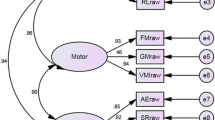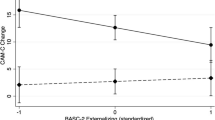Abstract
The aim of this study was to examine the responsiveness of the Psychoeducational Profile-third edition (PEP-3) in children with Autism Spectrum Disorders (ASD). We investigated the responsiveness in terms of three types of scores (i.e., raw scores, developmental ages, and percentile ranks) of the subtests and composites of the PEP-3 and three methods of analysis were used: effect size, standardized response mean, and paired t test. The findings generally support the use of the PEP-3 as an outcome measure. We suggest using the raw scores and developmental ages of the PEP-3 when evaluating program effectiveness and developmental changes for children with ASD.
Similar content being viewed by others
References
American Psychological Association (APA). (2000). Diagnostic and statistical manual of mental disorders: DSM-IV-TR (Fourth, Text Revision ed.). Washington, DC.
Centers for Disease Control Prevention (CDC). (2009). Prevalence of autism spectrum disorders—Autism and Developmental Disabilities Monitoring Network, United States, 2006 (Vol. 58, pp. 1–20). Morbidity & Mortality Weekly Report, Surveillance Summaries.
Cohen, J. (1977). Statistical power analysis for the behavior sciences. New York: Academic Press.
Cohen, I. L., Schmidt-Lackner, S., Romanczyk, R., & Sudhalter, V. (2003). The PDD Behavior Inventory: a rating scale for assessing response to intervention in children with pervasive developmental disorder. Journal of Autism and Developmental Disorders, 33, 31–45.
Delmolino, L. M. (2006). Brief report: Use of DQ for estimating cognitive ability in young children with autism. Journal of Autism and Developmental Disorders, 36, 959–963.
Deyo, R. A., & Centor, R. M. (1986). Assessing the responsiveness of functional scales to clinical change: An analogy to diagnostic test performance. Journal of Chronic Diseases, 39, 897–906.
Fu, C. P., Hsieh, C. L., Tseng, M. H., Chen, Y. L., Huang, W. T., Wu, P. C., et al. (2010). Inter-rater reliability and smallest real difference of the Chinese Psychoeducational Profile-third edition for children with Autism Spectrum Disorder. Research in Autism Spectrum Disorders, 4, 89–94.
Gabriels, R. L., & Hill, D. E. (Eds.). (2007). Growing up with autism: working with school-age children and adolescents New York. NY: Guilford Press.
Guyatt, G. H., Kirshner, B., & Jaeschke, R. (1992). Measuring health status: What are the necessary measurement properties? Journal of Clinical Epidemiology, 45, 1341–1345.
Guyatt, G. H., Osoba, D., Wu, A. W., Wyrwich, K. W., & Norman, G. R. (2002). Methods to explain the clinical significance of health status measures. Mayo Clinic Proceeding, 77, 371–383.
Hilton, C. L., Crouch, M. C., & Israel, H. (2008). Out-of-school participation patterns in children with high-functioning autism spectrum disorders. American Journal of Occupational Therapy, 62, 554–563.
Husted, J. A., Cook, R. J., Farewell, V. T., & Gladman, D. D. (2000). Methods for assessing responsiveness: A critical review and recommendations. Journal of Clinical Epidemiology, 53, 459–468.
Kirshner, B., & Guyatt, G. (1985). A methodological framework for assessing health indices. Journal of Chronic Diseases, 38, 27–36.
Kogan, M. D., Strickland, B. B., Blumberg, S. J., Singh, G. K., Perrin, J. M., & van Dyck, P. C. (2008). A national profile of the health care experiences and family impact of autism spectrum disorder among children in the United States, 2005–2006. Pediatrics, 122, e1149–e1158.
Lam, M. K., & Rao, N. (1993). Developing a Chinese version of the psychoeducational profile (CPEP) to assess autistic children in Hong Kong. Journal of Autism and Developmental Disorders, 23, 273–279.
Landrigan, P. J., Schechter, C. B., Lipton, J. M., Fahs, M. C., & Schwartz, J. (2002). Environmental pollutants and disease in American children: Estimates of morbidity, mortality, and costs for lead poisoning, asthma, cancer, and developmental disabilities. Environmental Health Perspectives, 110, 721–728.
Liang, M. H., Fossel, A. H., & Larson, M. G. (1990). Comparisons of five health status instruments for orthopedic evaluation. Medical Care, 28, 632–642.
Montes, G., & Halterman, J. S. (2006). Characteristics of school-age children with autism. Journal of Developmental and Behavioral Pediatrics, 27, 379–385.
Muris, P., Steerneman, P., & Ratering, E. (1997). Brief report: interrater reliability of the psychoeducational profile (PEP). Journal of Autism and Developmental Disorders, 27, 621–626.
Ozonoff, S., & Cathcart, K. (1998). Effectiveness of a home program intervention for young children with autism. Journal of Autism and Developmental Disorders, 28, 25–32.
Ozonoff, S., Goodlin-Jones, B. L., & Solomon, M. (2005). Evidence-based assessment of autism spectrum disorders in children and adolescents. Journal of Clinical Child & Adolescent Psychology, 34, 523–540.
Panerai, S., Ferrante, L., & Zingale, M. (2002). Benefits of the Treatment and Education of Autistic and Communication Handicapped Children (TEACCH) programme as compared with a non-specific approach. Journal of Intellectual Disability Research, 46, 318–327.
Panerai, S., Zingale, M., Trubia, G., Finocchiaro, M., Zuccarello, R., Ferri, R., et al. (2009). Special education versus inclusive education: The role of the TEACCH program. Journal of Autism and Developmental Disorders, 39, 874–882.
Rapin, I. (1991). Autistic children: Diagnosis and clinical features. Pediatrics, 87, 751–760.
Schopler, E., Lansing, M. D., Reichler, R. J., & Marcus, L. M. (2005). Examiner’s manual of Psychoeducational Profile (3rd ed.). Austin, TX: Pro-ed Incorporation.
Shek, D. T. L., Tsang, S. K. M., Lam, L. L., Tang, F. L. Y., & Cheung, P. M. P. (2005). Psychometric properties of the Chinese version of the Psycho-educational Profile-Revised (CPEP-R). Journal of Autism and Developmental Disorders, 35, 37–44.
Tomchek, S. D., & Case-Smith, J. (2009). Occupational therapy practice guidelines for children and adolescents with autism. Bethesda, MD: American Occupational Therapy Association Inc.
Wilkin, D., Hallam, L., & Doggett, M. (1992). Measures of need and outcome for primary health care. Oxford: Oxford University Press.
World Health Organization (WHO). (1992). International statistical classification of diseases and related health problems, 10th revision (ICD-10). Geneva, Switzerland: WHO.
Acknowledgments
This research was supported by grant 96-N-040 from the National Taiwan University Hospital. We gratefully acknowledge the support of the caregivers and children who participated in this study. This research would not have been possible without them.
Author information
Authors and Affiliations
Corresponding author
Rights and permissions
About this article
Cite this article
Chen, KL., Chiang, FM., Tseng, MH. et al. Responsiveness of the Psychoeducational Profile-third Edition for Children with Autism Spectrum Disorders. J Autism Dev Disord 41, 1658–1664 (2011). https://doi.org/10.1007/s10803-011-1201-5
Published:
Issue Date:
DOI: https://doi.org/10.1007/s10803-011-1201-5




